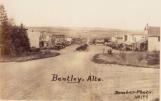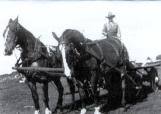18
The DrayIn almost any small town on the railroad, the dray, the drayman and his horses were a very important piece of history. Nearly one hundred percent of supplies for stores, lumber yards, equipment suppliers, etc. came by rail.
Our drayman, here in Bentley, met each train and picked up all the cargo, as the station master checked it off. He then took it "uptown" and delivered it to the proper destinations.
The dray itself was like a solid hayrack with very low sides. It was built up at the front and back to keep the cargo from sliding off, but there was a lot of open space to load it systematically.
Usually, the drayman's first priority was his horses. He took a great deal of pride in his team. It helped if he, himself, tended to be quite sociable and obliging, because there were often frustrating moments. The horses though were his pride and joy. Whether on runners in winter or wheels in summer, they had to be capable of pulling heavy loads. Remarkably, they had to be able to stand quietly next to a noisy, shunting, whistling train. The deliveries were then made to all the designated stores. Until a horse was well trained, the drayman had an iron ball about six inches in diameter on a chain, which he could snap on to a bridle to discourage unwanted movement from the horse. Everyone in town knew the horses by name and would stop to pat them as they walked down the street.
My first memory of a drayman, was of Web Damron. His horses were named Joe and Charlie. He was very proud of them. There were probably many other draymen over the years, but the one I remember best is Ernie Peterson. At the end of the war, the Bentley drayman was operated by George Dawson and his brother Marshall (Shorty). The Dawson's called their dray business "Dawson Brothers' Coal and Cartage". There was too much business for one team so the brothers bought another team and outfit. One team was fondly called "Big Blues". The main characteristic I recall about any of the draymen was their love and pride in their horses.
Roy Klopstra took over the dray business in the early 1950's. When he found the Bentley draying business too much for one man, Peter Attema joined him as a partner .By this time trucks had replaced the horses.
For some unknown reason, the dray itself was prone to Halloween hi-jinks. I can remember coming to school the morning after Halloween to find the dray on top of the school! It had been taken apart, piece by piece, and reassembled on the roof. Incidentally, it came back down the same way and was put back in ship-shape order again. I am quite sure that those rebuilding it were the same young bucks who had hoisted it up there the previous night.
As cars and trucks became more prevalent, the duties of the drayman gradually disappeared. Suppliers hauled the goods to the stores, or store owners had vehicles with which to haul their own supplies. Today there is no dray to haul supplies in Bentley. In fact, the train might only stop if it has tank cars to drop off on the siding. In many small towns the train no longer passes by.



